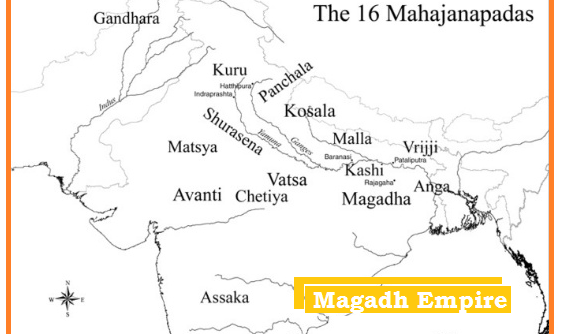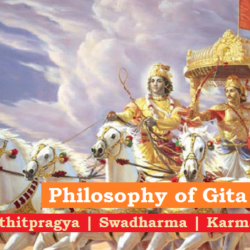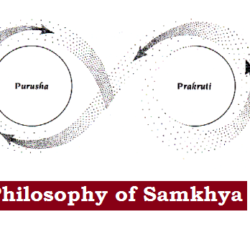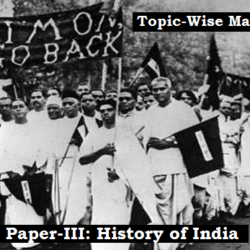
From the 6 century BC, the material advantages paved the way for the establishment of territorial kingdoms after Vedic period. ‘Jana’ or tribe was now given lesser importance as people owed strong allegiance to the Janapada or territory.
The Mahajanapadas:
- In 6 century BC (at the age of Buddha) there were 16 large states called Mahajanpadas, situated north of Vindhyas.
- Some of them were: (See the map above)
- Anga with capital Champa (modern Munger and Bhagalpur)
Vajji with capital Vaishali (modern Vaisali) - Kashi with capital Varanasi
Koshala with capital Shravasti (modern Gonda, Bahraich) - Vatsas with capital Kaushambi (modern Allahabad)
Avanti with capital Ujjain
Magadha with capital Rajgir and Patliputra
- Anga with capital Champa (modern Munger and Bhagalpur)
Magadha Mahajanapada emerged to be most powerful kingdom and succeeded in founding an empire. They established their capital at Rajgir, which was called Girivraj at that time, which was surrounded by 5 hills.
Rise of Magadh Empire
Haryanka Dynasty
- Bimbisara: Contemporary of Buddha
- Under leadership of Bimbisara (contemporary of Buddha), his conquest and aggression incorporated other kingdoms into the empire.
- He also strengthened his position in north and west by marriage alliance with Koshala, Vajji and Madra (Punjab) kingdoms.
- He had three wives: Kosaladevi (King of Kosala’s daughter and the sister of Prasenjit), Chellana (daughter of the Lichchavi chief of Vaisali) and Khema (daughter of the king of Modra, Punjab).
- Avanti was the most serious rival to Magadh and finally established diplomatic relationship with king Chanda Pradyota Mahasena. Later when Pradyota was suffering from Jaundice, he sent royal physician JIvaka to Ujjain.
- Ajatshatru:
- Bimbisara was succeeded by his son Ajatshatru who killed his father and seized the throne.
- He continued the policy of expansion through conquest and diplomacy.
- He married to the Kosalan princess.
- He enlarged his kingdom by adding Kasi and Vaishali (though his maternal state). He possessed a chariot with a war engine like catapult to throw stone, which facilitated mass killings.
- Avanti still was the most serious rival to Magadh, which had defeated Vatsas.
- Udayin:
- Udayin succeeded him, he shifted his capital to Patliputra for its strategic location, at the confluence of three river-Ganga, Son and Punpun.
- He consolidated the new capital and fortified it.
Shishunga Dynasty
- Udayin was succeeded by Shishunaga- the viceroy at Banaras.
- Shishunaga destroyed the power of Avanti and incorporated into Magadh Empire ending the 100- years old rivalry.
- His son Kalasoka conducted Second Buddhist Council at Vaishali.
Nanda Dynasty
- Mahapadma Nanda:
- He murdered Kalasoka to succeed Kalasoka, he claimed to be Ekarat, the sole sovereign who destroyed all the other rulers.
- He acquired Kalinga to extend the kingdom from southern Godavari Valley to eastern parts of Punjab and also defeated Kosala, which had probably rebelled against him.
- Dhana
Nanda:
- Nandas proved to be the most powerful rulers of Magadha Empire. Alexander, who invaded Punjab at 326 BC did not dare to move eastwards due to the fear of Magadh’s huge army.
- He became unpopular with his subjects owing to an oppressive way of extorting taxes. Also, his Sudra origins and an anti-kshatriya policy led to a large number of enemies.
Causes of Magadha’s Rise:
- Political
Factors:
- It was a combined task of several ambitious rulers through all means, fair and foul.
- They maintained a strong army which first used elephants in their credit. Even Alexander’s army was told about the formidable power on Ganga.
- Geographical
Factors:
- Advantageous geographical position with iron rich areas which enabled them to have strong weapons.
- The strategic location of capital Rajgir which was surrounded by 5 hills and provided a natural fort.
- Later capital Patliputra occupied a pivotal position in commanding communication to all sided, which was surrounded by three rivers– Ganga, Son, Punpun. It made Patliputra invulnerable because of being surrounded by rivers on almost all sides.
- Economic
Factors:
- The fertile Gangetic plain led to surplus agricultural production and rise of cities and effective taxation system.
- Developed trade and commerce helped to accumulate wealth (use of coins).
- Cultural
Factors:
- Magadhan society was recently aryanized with a good mix of Aryan and non-Aryan people.
- The inhabitants- Kiratas and Magadhas, were held in low esteem by the orthodox Brahmans. They showed more enthusiasm for expansion than Vedic period kindgoms.
- Emergence of Jainism and Buddhism led to enhanced liberal traditions.

 Home
Home Syllabus
Syllabus Contact Us
Contact Us








